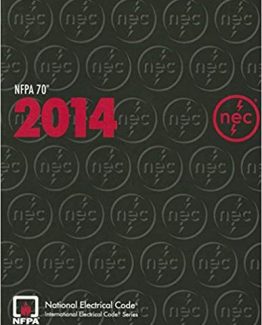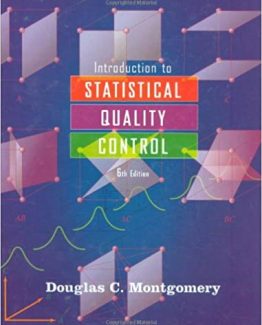Engineering Economics for Aviation and Aerospace by Bijan Vasigh, ISBN-13: 978-1138185784
[PDF eBook eTextbook]
- Publisher: Routledge; 1st edition (December 13, 2016)
- Language: English
- 588 pages
- ISBN-10: 1138185787
- ISBN-13: 978-1138185784
For all engineers and practitioners, it is essential to have a fundamental understanding of cost structure, estimating cash flows, and evaluating alternative projects and designs on an economic basis. Engineering Economics for Aviation and Aerospace provides the tools and techniques necessary for engineers to economically evaluate their projects and choices.
The focus of this book is on a comprehensive understanding of the theory and practical applications of engineering economics. It explains and demonstrates the principles and techniques of engineering economics and financial analysis as applied to the aviation and aerospace industries. Time value of money, interest factors, and spreadsheet functions are used to evaluate the cash flows associated with a single project or multiple projects. The alternative engineering economics tools and techniques are utilized in separate chapters to evaluate the attractiveness of a single project or to select the best of multiple alternatives.
Most of the engineering economics and financial mathematics books available in the market take either a pure theoretical approach or offer limited applications. This book incorporates both approaches, providing students of aviation and industrial economics, as well as practitioners, with the necessary mathematical knowledge to evaluate alternatives on an economic basis.
Table of Contents:
List of Figures
List of Tables
Preface
Foreword by Brian Pearce
Foreword by Zane Rowe
Foreword by Dr Barry Humphreys CBE
Acknowledgments
List of Abbreviations
1 Introduction to the Air Transport Industry
Airline Industry before Deregulation
Airline Industry after Deregulation
Airline Profitability
Air Transport Industry
Aircraft Manufacturers
Jet Engine Manufacturers
Aircraft Leasing Companies
Service Providers (MRO, Ground Handling, Catering)
Airports
Air Navigation Service Providers (ANSP)
Global Distribution System (GDS) and Computer Reservation System (CRS)
Freight Forwarders and Integrators
Airline Mergers and Bankruptcies
Summary
Discussion Questions and Problems
2 Foundations of Engineering Economics and Finance
Definition of Engineering Economics
Interest and Time Value of Money
Simple Interest
Compound Interest
The Connection between Interest Rates and Their Determinations
Short-term Interest Rates
Long-term Debt and Interest Rates
Future Value of a Single Present Amount
Present Value of a Single Future Sum
Future Value of an Unequal Cash Flow Series
The Rule of 72
The Rule of 100
Summary
Discussion Questions and Problems
3 Annuities and Gradient Series
Annuities or Uniform Series
Future Value of an Annuity
Annuity of a Future Value
Present Value of an Annuity
Annuity of a Present Value
Amortization and Amortization Schedule
Annuity Due
Capitalized Cost
Arithmetic Gradient Series
Present Value of an Arithmetic Gradient Series
Annuity of an Arithmetic Gradient Series
Future Value of an Arithmetic Gradient Series
Geometric Gradient Series
Present Value of a Geometric Gradient Series
Annuity of a Geometric Gradient Series
Future Value of a Geometric Gradient Series
Shifted Cash Flow Series
Using Spreadsheets for Equivalences Computation
Summary
Discussion Questions and Problems
4 Nominal and Effective Interest Rates
Nominal Versus Effective Interest Rates
Calculating Effective Interest Rate
Continuous Compounding
Effective Rate to Nominal Rate
Comparing Compounding Periods and Payment Periods
Computing Equivalences Involving Only Single-Amount Factors.
Computing Equivalences when Payment Period Equals Compounding Period
Computing Equivalences when Payment Period Exceeds Compounding Period
Computing Equivalences when Payment Period is Less Than Compounding Period
Using Spreadsheets for Effective Rate and Equivalences Computation
Summary
Discussion Questions and Problems
5 Analysis of Present Worth
Measuring Project Cash Flows
First Cost (P)
Net Annual Cash Flow (NACF)
Terminal Cash Flow (TCF)
Evaluation of Single Projects
Bond Valuation
Types of Project Alternatives
Mutually Exclusive (ME) Projects
Independent Projects (IP)
Do-nothing Alternative
Evaluation of Mutually Exclusive Equal-life Alternatives
Evaluation of Mutually Exclusive Different-life Alternatives
Study Period Approach
Least Common Multiple or Replacement Chain Approach
Capitalized Cost or Equivalent Annual Annuity Approach
Evaluation of Independent Projects
Using Spreadsheets for Present Worth Computation
Life Cycle Costing (LCC)
Summary
Discussion Questions and Problems
6 Analysis of Annual Worth
Motivation for Using Annual Worth Analysis
Evaluation of Single Projects
Capital Recovery
Annuity of Net Annual Cash Flows
Evaluation of Mutually Exclusive Projects
Annual Worth Analysis of Equal-life Alternatives
Annual Worth Analysis of Non-Equal-life Alternatives
Evaluation of Independent Projects
Annual Worth of Permanent Projects
Using Spreadsheets for Annual Worth Computation
Summary
Discussion Questions and Problems
7 Analysis of Rate of Return
Rate of Return Calculation
Interpretation of Rate of Return Values
Trial and Error Method
Rate of Return of Bonds
Evaluating Mutually Exclusive Projects
Incremental Cash Flows
Cost-based Alternatives
Revenue-based Alternatives
Equal-life Service Requirement
Evaluating Independent Projects
Complications with Rate of Return
Multiple Rates of Return Scenario
ROR Reinvestment Rate Assumption
Modified Rate of Return Analysis
Using Spreadsheets for Rate of Return Computation
Summary
Discussion Questions and Problems
8 Public Sector Projects and Benefit to Cost Analysis
Public Sector versus Private Sector Projects
Benefit/Cost Analysis of Single Projects
Evaluation of Cost-based Mutually Exclusive Alternatives
Evaluation of Benefit-based Mutually Exclusive Alternatives
Evaluation of Independent Projects
Modified Benefit and Cost Analysis
Using Spreadsheets for Benefit/Cost Ratio Computation
Summary
Discussion Questions and Problems
9 Analysis of Break-even and Payback Period
Introduction to Break-even Analysis
Elements of Break-even Analysis
Break-even Analysis of a Single Project when Interest is Equal to Zero
Break-even Analysis between Two Alternatives with Interest Rate of Zero
Break-even Analysis of a Single Project with Interest Rate Greater than Zero
Break-even Analysis of Mutually Exclusive Alternatives with Interest Rate Greater than Zero
Airline Break-even Load Factor
Introduction to Payback Period Analysis
Conventional Payback Period Analysis
Discounted Payback Period Analysis
Using Spreadsheets for Break-even
Analysis and Payback Periods
Summary
Discussion Questions and Problems
10 Uncertainty, Risk Analysis, and Simulation
Decision Making
Probability and Business Decisions
Cumulative Probability Distribution
Joint Probability Distribution
Measuring Risk and Reward
Sample Space
Expected Return or Mean
Variance
Standard Deviation
Calculating Variance and Standard Deviation Using Spreadsheets
Normal Distribution
Calculating Normal Distribution Probability Using Spreadsheets
Standard Normal Distribution
Portfolios
Portfolio Beta
Capital Asset Pricing Model (CAPM)
Security Market Line (SML)
Sensitivity Analysis
Break-even Analysis
Monte Carlo Analysis (Simulation)
Summary
Discussion Questions and Problems
11 Analysis of Depreciation, Replacement, and Abandonment
Introduction
Depreciation Methodologies
Straight Line Depreciation (SL) Method
Declining Balance Depreciation (DB)
Modified Accelerated Cost Recovery System (MACRS)
Sum-of-the-Years Digits (SYD) Method
Comparison of Different Approaches to Depreciation
Using Spreadsheets for Depreciation Computations
Basics of a Replacement Decision
Impairment
Abandonment
Summary
Discussion Questions and Problems
12 Engineering Cost EstimationDefinition of Cost.
Fixed Costs (FC)
Variable Costs (VC)
Total Costs (TC)
Cubic Cost Function
Marginal Costs (MC)
Average Total Cost (ATC)
Average Fixed Cost (AFC)
Average Variable Cost (AVC)
Sunk Costs
Opportunity Costs
Relationship between Economic and Accounting Cost
Cost of Debt
Cost of Equity
Weighted Average Cost of Capital (WACC)
ROIC vs WACC
Cost Divisions and Categories
Direct Costs
Indirect Costs
Learning Curve
Estimating Costs
Cost Estimation Techniques
Unit Cost Method
Cost Index Method
Cost Capacity Equation
Cost Factor Method
Indirect Cost Estimation and Allocation
Airline Cost Structure
Operating Costs (OC)
Non-operating Costs (NOC)
Summary
Discussion Questions and Problems
13 Analysis of Financial Statements
The Income Statement: Measuring a Firm’s Profits
Revenue, Sales, or Income
Cost of Goods Sold (COGS)
Operating Expenses
Depreciation
Operating Profit
Financial Costs
Net Income
The Balance Sheet: Measuring a Firm’s Book Value
Current Assets
Fixed Assets (Non-current Assets)
Total Liabilities
Current Liabilities
Non-current
Liabilities
Stockholders’ Equity
Statement of Cash Flow
Cash Flow from Operating Activities
Cash Flow from Investing Activities
Cash Flow from Financing Activities
Measuring Free Cash Flow
Common Size Financial Statements
Common Size Income Statement
Common Size Balance Sheet
Summary
Discussion Questions and Problems
14 Analysis of Financial Ratios
Liquidity Ratios
Current Ratio (CR)
Quick Ratio (QR)
Asset Management Ratios
Accounts Receivable Turnover Ratio (ART)
Average Collection Period (ACP)
Inventory Turnover (ITO)
Fixed Asset Turnover Ratio (FAT)
Total Asset Turnover Ratio (TAT)
Financial Management Ratios
Debt Ratio (D/A)
Debt to Equity Ratio (D/E)
Times Interest Earned Ratio (TIE)
Profitability Ratios
Gross Profit Margin (GPM)
Operating Profit Margin (OPM)
Net Profit Margin (NPM)
Return on Total Assets (ROA)
Return on Equity (ROE)
Dividend Ratios
Dividend Payout Ratio (DPR)
Dividend Yield
Market Value Ratios
Market to Book Ratio
Price–Earnings Ratio (P/E Ratio)
DuPont System Ratios
Return on Assets (ROA)
Return on Equity (ROE)
Window Dressing
Altman Insolvency Index
Key Financial Ratios for the Airline Industry
Available Seat Mile (ASM)
Revenue Passenger Mile (RPM)
Cost per Available Seat Mile (CASM)
Revenue per Available Seat Mile (RASM)
Revenue per Revenue Passenger Mile (RRPM) or Passenger Yield
Average Stage Length (ASL)
CASM (Stage Length Adjusted)
Average Daily Block Hour Utilization
Load Factor (LF)
Break-even
Load Factor (LFb-e)
Summary
Discussion Questions and Problems
15 Fundamentals of Decision Theory
Decision-making Process
Decision Trees
Nodes
Branches
Decision Environments
Decisions under Certainty
Decisions under Uncertainty
Decisions under Risk
The Economic Theory of Information
Expected Value of Perfect Information (EVPI)
EV with PI
Queueing Theory
Customer Arrivals
Arrival Characteristics
Waiting Line Characteristics
Service Facility Characteristics
Cost–Capacity Tradeoff
Summary
Discussion Questions and Problems
Appendix A
Appendix B
Appendix C
Appendix D
Appendix E
Appendix F
Glossary
Index
Bijan Vasigh is Professor of Economics and Finance in the College of Business at Embry-Riddle Aeronautical University, Daytona Beach, Florida, USA.
Javad Gorjidooz is the Chair of the Business Administration Program and Professor of Finance in the School of Business at Embry-Riddle Aeronautical University, Prescott, Arizona, USA.
What makes us different?
• Instant Download
• Always Competitive Pricing
• 100% Privacy
• FREE Sample Available
• 24-7 LIVE Customer Support






Reviews
There are no reviews yet.